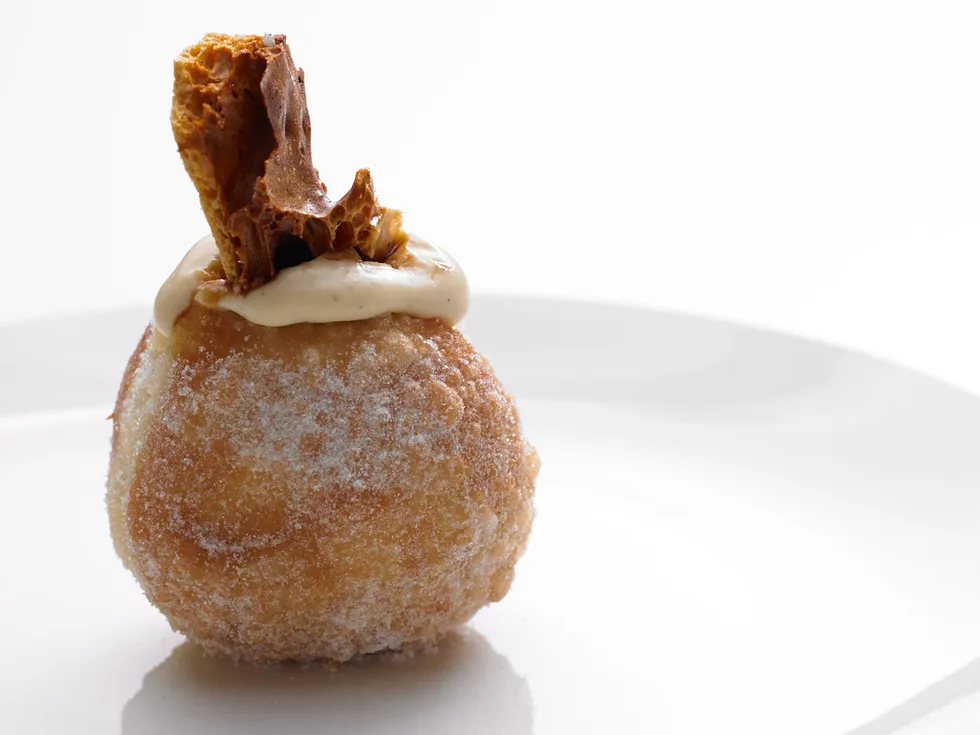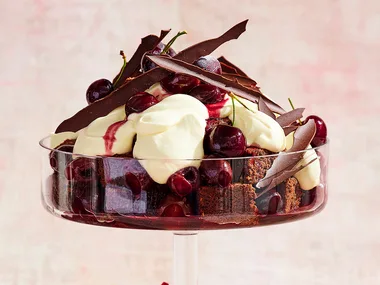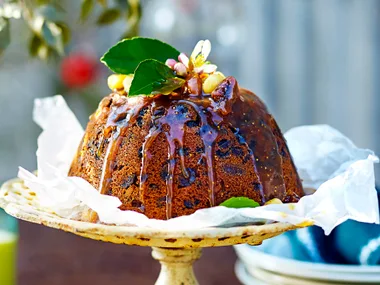Ingredients
The donut dough
Custard (creme patissiere)
Bay lead custard
Salted honeycomb
Method
The donut dough
1.Put all the dough ingredients, apart from the butter, into the bowl of an electric mixer with a beater attachment. Mix on a medium speed for 8 minutes, or until the dough starts coming away from the sides and forms a ball.
2.Turn off the mixer and let the dough rest for 1 minute. Take care that your mixer doesn’t overheat – it needs to rest along with the dough.
3.Start the mixer up again on a medium speed; slowly add the butter to the dough – about 25g at a time. Once it is all incorporated, mix on high speed for 5 minutes, until the dough is glossy, smooth and very elastic when pulled, then cover the bowl with clingfilm and leave to prove until it has doubled in size. Knock back the dough, then recover the bowl and put into the fridge to chill overnight.
4.The next day, take the dough out of the fridge and cut it into 50g pieces (you should get about 20). Roll them into smooth, taut, tight buns and place them on a floured baking tray, leaving plenty of room between them as you don’t want them to stick together while they prove. Cover lightly with clingfilm and leave for about 4 hours, or until about doubled in size.
5.Get your deep-fat fryer ready, or get a heavy based saucepan and fill it up to the halfway point with canola oil (please be extremely careful, as hot oil is very dangerous). Heat the oil to 180°C.
6.When the oil is heated to the correct temperature, carefully remove the doughnuts from the tray by sliding a floured pastry scraper underneath them, taking care not to deflate them, and put them into the oil. Do not overcrowd the fryer – do 2-3 per batch, depending on the size of your pan. Fry for 2 minutes on each side until golden brown – they puff up and float, so you may need to gently push them down after about a minute to help them colour evenly.
7.Remove from the fryer and place on kitchen paper; then toss them in a bowl of caster sugar while still warm. Repeat until all are fried BUT make sure the oil temperature is correct every time before you fry – if it is too high they will colour too quickly and burn, and will be raw in the middle, and if it is too low the oil will be absorbed into the doughnut and it will become greasy. Set aside to cool before filling.
8.To fill the doughnuts: make a hole in the crease of each one (anywhere around the white line between the fried top and bottom). Fill a piping bag with your desired filling and pipe into the doughnut until swollen with pride. Roughly 20-50g is the optimum quantity, depending on the filling; cream will be less, because it is more aerated. You can fit in more than this, but it doesn’t give such a good balance of dough to filling.
Custard (creme patissiere)
9.Slit the vanilla pod open lengthways and scrape out the seeds. Put both pod and seeds into a heavy-based saucepan with the milk and bring slowly just to the boil, to infuse the vanilla.
10.Meanwhile place the egg yolks and the 125g of sugar in a bowl and mix together for a few seconds, then sift in the flour and mix again.
11.Pour the just-boiling milk over the yolk mixture, whisking constantly to prevent curdling, then return the mixture to the saucepan. Cook over a medium heat, whisking constantly for about 5 minutes, until very thick.
12.Pass through a fine sieve, discarding the vanilla, and place a sheet of Clingfilm on the surface of the custard to prevent a skin forming. Leave to cool, then refrigerate.
13.Whip the cream and the 2 tablespoons of sugar together until thick but not over-whipped and fold into the chilled custard.
Bay leaf custard
14.In a heavy based saucepan place the milk then crunch up the bay leaves and add to the milk, place on a medium heat and slowly bring to boil to infuse the bay.
15.Meanwhile place the egg yolks and sugar in a bowl and mix together for a few seconds, then sieve the flour in and again mix together.
16.Pour the boiling milk over the yolk mixture, whisking constantly to prevent curdling, and then return to the mixture to the saucepan. Cook over a medium heat, whisking constantly for around 5 minutes until very thick.
17.Pour the boiling milk over the yolk mixture, whisking constantly to prevent curdling, and then return to the mixture to the saucepan. Cook over a medium heat, whisking constantly for around 5 minutes until very thick.
18.Leave to cool and then refrigerate.
19.Whip the cream and sugar together until thick and fold into the chilled custard.
20.Garnish with a bay leaf in each doughnut
Salted honeycomb
21.Line a large baking tray with baking paper.
22.Put the honey, glucose, sugar and water into a saucepan and bring to the boil, stirring a little to dissolve the sugar; then reduce the heat and simmer until a light brown caramel is reached (about 10 minutes).
23.Turn off the heat and whisk in the sifted bicarbonate of soda for 5 seconds. Watch out, as it will fizz and bubble straight away. Pour on to your prepared tray and leave to cool completely and harden.
24.When cold, sprinkle with a good pinch of sea salt and break into small pieces. Store in an airtight container.
The doughnuts are best eaten straight away, but will keep in an airtight tin and can be reheated to refresh them.
Note










